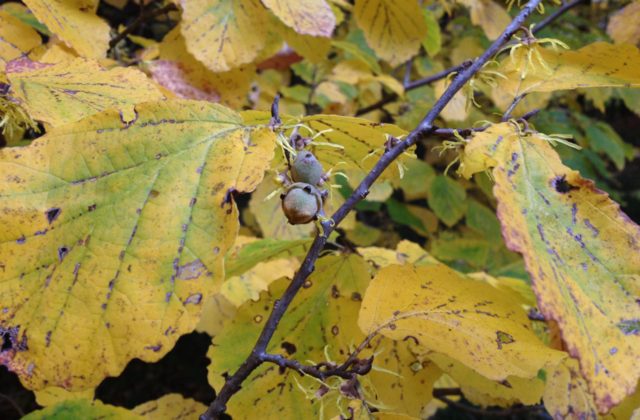Autumn Bewitchment
By Hans M. Carlson
I took a walk south of Yale Camp yesterday, enjoying both the warm weather and the beautiful fall leaves. Despite dire predictions that the drought would hurt the colors—made as much by me as anyone—the season has been spectacular thus far. And as I walked the old Chattleton Road, I caught sight of another sure sign of the passing of the season. Among all the other color, there were the first signs of the yellow blossoms of the witch hazel—those bewitched denizens of the forest understory that put out their flowers in late fall, instead of the spring.
Just as trillium and mountain laurel herald the beginning of the season, so witch hazel marks its end, though it’s unclear why it waits so long to begin reproducing each year. There are certainly disadvantages to this behavior, not the least of which is the dearth of pollinators as the weather gets colder. No insect takes the risk of specializing in witch hazel, and only about one percent of its flowers ever set fruit. The various flies, beetles, and bees who do visit are winding down their season, and are not nearly as efficient as earlier in the year. The low fruiting rate is also because fertilization of the ovule—something that most plants do right after pollination—doesn’t happen in witch hazel until the following spring.
Given all this odd behavior, people in the past can be forgiven for thinking that witch hazel was under some sort of enchantment. And maybe this is what provoked them to investigate the shrub’s medicinal qualities, though it’s more likely that they learned about using the plant from native peoples. It’s possible too that the connection with American Indian medicine is what prompted Europeans to think in terms of witchcraft, but whatever the case, use it they did. Then and now its astringent qualities make it an effective remedy for all sorts of skin conditions and insect bites, and despite all its idiosyncrasies, witch hazel remains a significant forest product in Connecticut.
The familiar clear liquid you get at the pharmacy is distilled from the bark and wood, and the process is basically unchanged since the Dickenson Company began operations in Essex, Conn. in 1866. Stems are cut in the winter and then chipped, before being shipped to the distillery for processing. When the chips have given up their essence, they are turned into mulch, so little goes to waste in processing. In addition to forming the basis of the liquid form, witch hazel is used in other skin products, such as deodorant and soap. Connecticut is still the biggest processor, thanks to the ready access of raw materials and the long history of production here.
It was about 15 years ago that these witch hazel bushes south of Yale Camp were harvested, and if you look closely you will see the stumps beneath the new growth that has come up since. Great Mountain Forest (GMF) contracted Norfolk local Gene Buyak, a witch hazel specialist, to conduct the harvest. He cut and piled the brush into one-ton stacks and then used a chipper borrowed from the Dickenson Company to process about 200 tons of raw material. This was GMF’s first adventure in harvesting witch hazel, but the plants have now regrown to a point where another harvest is possible.
Witch hazel sprouts vigorously from cut stumps, and so makes up for its odd reproductive habits. It particularly likes the edge of fields, or, in the case of these bushes, the sides of an old road. One unforeseen side effect of the last harvest was that the machinery tilled up acorns which have sprouted into nice young oak trees. So if there is to be another witch hazel harvest, these will have to be protected. Both witch hazel and oak are valuable forest products that we will manage for the future, even as we enjoy the colors and the odd bewitching yellow flowers of fall.
Photo: The flower of the witch hazel takes the form of a stringy yellow ribbon and appears before the fruit has fallen.

